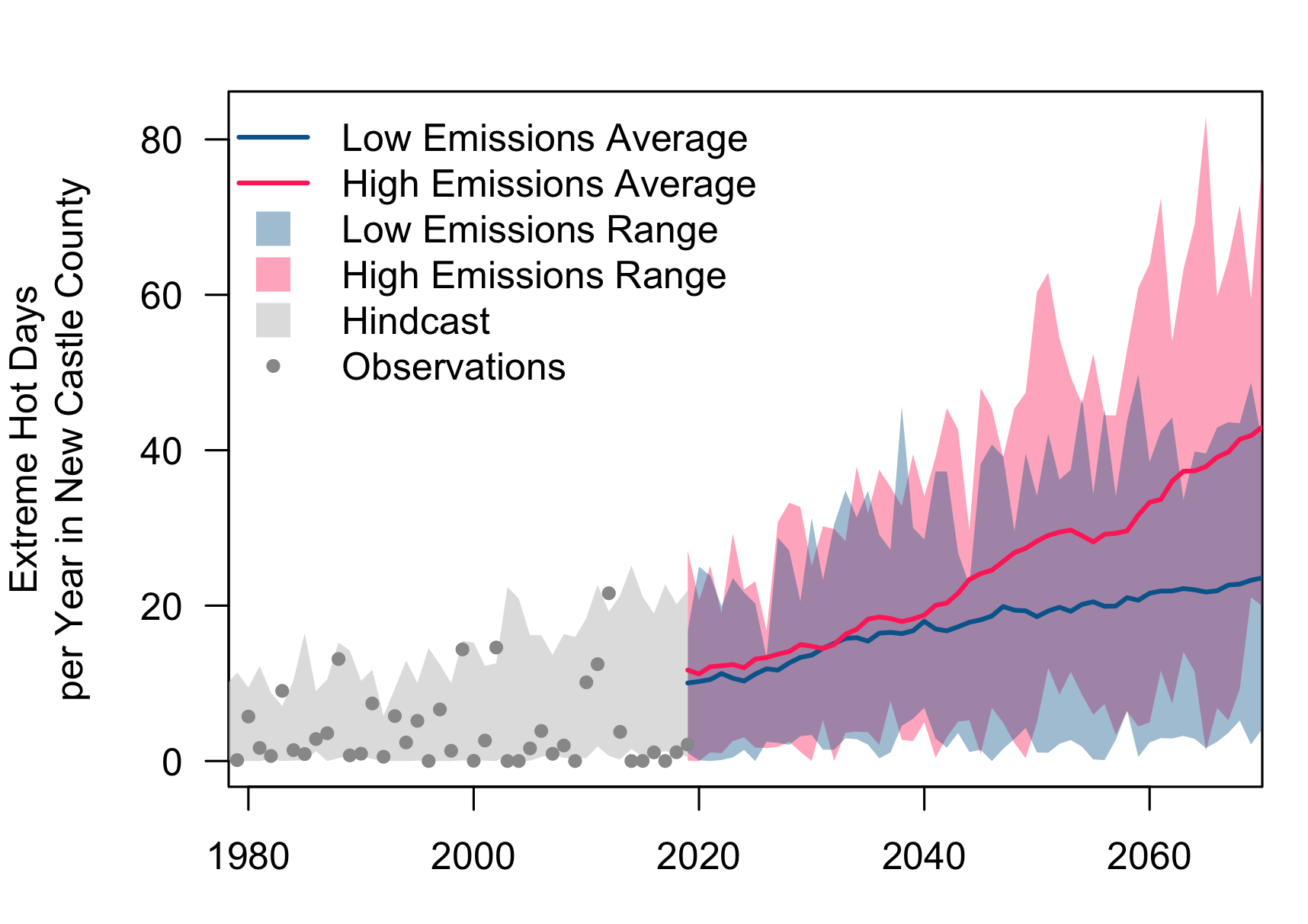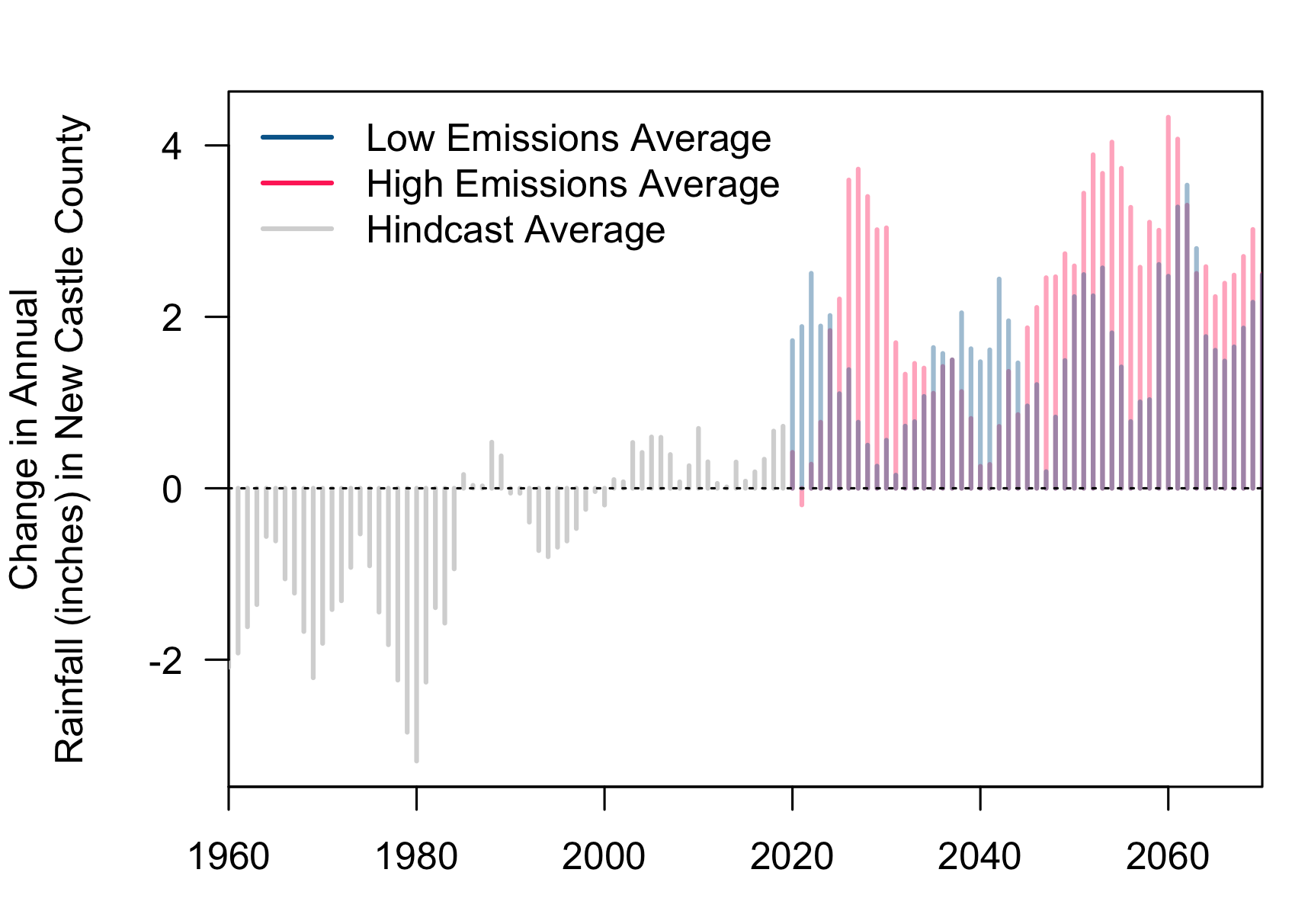New Castle County, DE
New Castle County residents will face increasingly severe weather-related hazards, such as heat waves, flooding, and storm surge.
As the frequency and intensity of local hazards change, it is important for all of us to protect communities and local habitats. Using the best data, scientists can project how long-term averages in daily weather will change in the future, and the effects this will have on localities.
Information on extreme weather and hazards can empower citizens, decision-makers, and other stakeholders to make infored risk-reduction decisions. With planning and preparation, New Castle County can reduce risks for all residents.

Changing Temperature Patterns
Human health, wildlife, and infrastructure are all threatened by higher temperatures. At 95°F, it is hard to keep indoor areas and our bodies cool. New Castle County’s summers are getting hotter and this is intensified by the Heat Island effect1. On average, New Castle County sees 4 days per year with temperatures above 95°F (1990-2019 average). Within the next 50 years (by 2070), New Castle County can expect a yearly average of 24 to 43 days above 95°F, with associated increases in cooling costs, reduced air quality, and heat-related illnesses.
![]() HEAT-RELATED ILLNESSES: Heatwaves can kill people and pets, and can cause difficulty breathing, exhaustion, cramping, and heatstroke. Individuals at higher risk include children, pregnant women, older adults, outdoor workers, and lower-income residents.
HEAT-RELATED ILLNESSES: Heatwaves can kill people and pets, and can cause difficulty breathing, exhaustion, cramping, and heatstroke. Individuals at higher risk include children, pregnant women, older adults, outdoor workers, and lower-income residents.
![]() ENERGY USE: Heat islands increase the demand for air conditioning. In the US, electricity demand for cooling will increase by 5-20% for every added degree C. During heatwaves, increased demand can overload systems causing power companies to conduct rolling brownouts or blackouts to avoid system failure.
ENERGY USE: Heat islands increase the demand for air conditioning. In the US, electricity demand for cooling will increase by 5-20% for every added degree C. During heatwaves, increased demand can overload systems causing power companies to conduct rolling brownouts or blackouts to avoid system failure.

The graph shows the number of days in a year with temperatures above or equal to 95°F. Dots represent observed annual days of extreme temperatures and the gray shading shows the hindcast2. Two scenarios of the future are shown as a high-emissions scenario (RCP 8.5) in red and a low-emissions scenario (RCP 4.5) in blue. Data for the future scenarios are retrieved from Multivariate Adaptive Constructed Analogs (MACA), and observed data are from the Gridded Surface Meteorological Dataset (gridMET).
Changing Rainfall Patterns
Heavy rainfall in New Castle County is increasing in frequency and intensity, causing property damage, septic backups, mold and indoor air quality issues, and impacts to water quality in wells, local streams, the Chesapeake and Delaware Bays. Annual rainfall in New Castle County will likely increase by an average of 2 to 3 inches (2050-2079 average compared to the 1990-2019 average).
![]() FLOODING: Heavy rain overwhelms infrastructure and drainage systems, causing property damage. It can cover streets and become deadly to drivers.
FLOODING: Heavy rain overwhelms infrastructure and drainage systems, causing property damage. It can cover streets and become deadly to drivers.
![]() REDUCED HUMAN HEALTH: Changing moisture levels impact the spread of illness including health issues from mold and reduced air quality. Changing moisture levels also support tick- and mosquito-borne diseases as high humidity promote their growth, reproduction, and how far they can travel.
REDUCED HUMAN HEALTH: Changing moisture levels impact the spread of illness including health issues from mold and reduced air quality. Changing moisture levels also support tick- and mosquito-borne diseases as high humidity promote their growth, reproduction, and how far they can travel.

The graph shows the change in annual rainfall compared to the average between 1990 and 2019. The gray lines show the hindcast. Two scenarios of the future are shown as a high-emissions scenario (RCP 8.5) in red and a low-emissions scenario (RCP 4.5) in blue. Data for the future scenarios are retrieved from MACA.
Sea Level Rise
As temperatures warm, land ice melts and seawater expands causing sea levels to rise around the world and in Delaware Bay, Chesapeake Bay, and the tidal Delaware River. Between 1960 and 2019, sea levels near New Castle County rose roughly 0.8 feet leading to more frequent and severe coastal flooding, and property damage. Sea levels will rise an additional 0.7 to 2.6 feet in the next 50 years (by 2070), submerging neighborhoods, threatening the commuter rail stations, and damaging infrastructure in and around Wilmington.
![]() STORM SURGE: Rising sea levels increase the impacts of storm surge allowing waves and severe flooding to reach further inland. Storm surge can damage properties and cause serious injury or death.
STORM SURGE: Rising sea levels increase the impacts of storm surge allowing waves and severe flooding to reach further inland. Storm surge can damage properties and cause serious injury or death.
![]() TIDAL FLOODING: Rising sea levels allow tides to push further inland causing more frequent high tide flooding and pushes the salt line further up rivers and streams, putting low-lying housing, commercial property, and infrastructure at risk. Repeated tidal flooding disrupts everyday life by closing roads and overwhelming storm drains.
TIDAL FLOODING: Rising sea levels allow tides to push further inland causing more frequent high tide flooding and pushes the salt line further up rivers and streams, putting low-lying housing, commercial property, and infrastructure at risk. Repeated tidal flooding disrupts everyday life by closing roads and overwhelming storm drains.

The graph shows the projected change of sea level in feet above mean sea level relative to 2000. The blue line shows the intermediate scenario (50% probability) and the blue shading shows the low to high scenario range (5 to 95% probability) of sea level rise used for official planning purposes in the state of Delaware. Dots show the observed changes in sea level in Lewes, DE. Data for the future scenarios are based on a high-emissions scenario (RCP 8.5).
Development of the Local Hazard Outlooks was supported by the National Oceanic and Atmospheric Administration (NOAA) grants NA18OAR4310302 and NA21OAR4310310.
v2.0-beta1 2025-06-04
